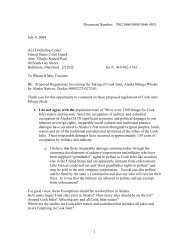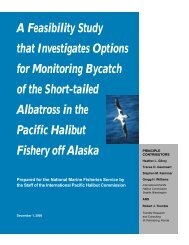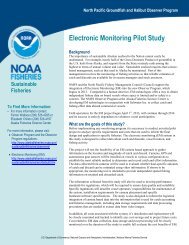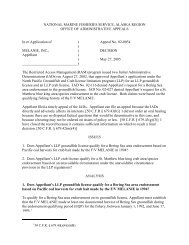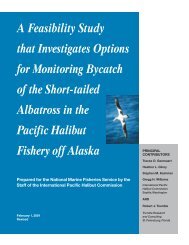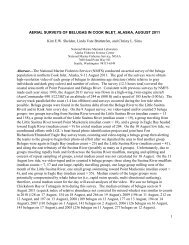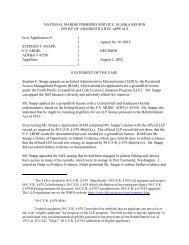Petition to List Lynn Canal Pacific Herring under the Endangered ...
Petition to List Lynn Canal Pacific Herring under the Endangered ...
Petition to List Lynn Canal Pacific Herring under the Endangered ...
You also want an ePaper? Increase the reach of your titles
YUMPU automatically turns print PDFs into web optimized ePapers that Google loves.
3. Marked Difference in Genetic Characteristics<br />
The DPS Policy allows NMFS <strong>to</strong> use evidence that <strong>the</strong> discrete population<br />
segment differs markedly from o<strong>the</strong>r populations of <strong>the</strong> species in its genetic<br />
characteristics <strong>to</strong> meet <strong>the</strong> “significance” prong of <strong>the</strong> DPS Policy (USFWS-NMFS<br />
1996). However, <strong>the</strong> question of what constitutes a marked genetic difference is unique<br />
<strong>to</strong> each species. Past USFWS and NMFS final rules designating DPSs have utilized<br />
varying standards for “significance” in <strong>the</strong> context of genetic differentiation. One thing is<br />
certain, <strong>the</strong> DPS Policy does not require a population <strong>to</strong> be genetically “unique” in order<br />
<strong>to</strong> qualify as “significant” (USFWS-NMFS 1996).<br />
As explained above in <strong>the</strong> discreteness section, <strong>the</strong> genetics of <strong>Pacific</strong> <strong>Herring</strong> are<br />
complicated. In addition, marine fish species generally have lower detectable levels of<br />
genetic differentiation than for terrestrial or anadromous species (Grant and Utter 1984,<br />
Bekkevold 2005). Therefore, just because <strong>the</strong> levels of detectable genetic variation are<br />
low does not mean that <strong>the</strong> observed genetic differentiation is insignificant. Even small<br />
amounts of genetic differentiation can be significant <strong>to</strong> <strong>the</strong> species. This is <strong>the</strong><br />
conclusion of several authors studying herring genetics.<br />
Bentzen (1997) advocates that if even one of several loci yields a significant<br />
result, it may be biologically meaningful given <strong>the</strong> obstacles (huge population<br />
sizes, sampling biases) faced in detecting legitimate population differences in <strong>the</strong><br />
marine environment.<br />
(McPherson et al. 2001).<br />
These conclusions run contrary <strong>to</strong> NMFS (2005c) assertions in <strong>the</strong> 12-month<br />
finding for Cherry Point <strong>Herring</strong>. In that finding, NMFS argued that <strong>the</strong> low levels of<br />
observed genetic differentiation in Cherry Point <strong>Herring</strong>, when compared <strong>to</strong> genetic<br />
differentiation observed in <strong>Pacific</strong> salmon species, is not “significant” (NMFS 2003c).<br />
However, according <strong>to</strong> herring researchers, even low levels of genetic differentiation can<br />
be significant.<br />
a) Uncertainty in Genetic Evidence<br />
The ESA requires NMFS <strong>to</strong> act in a precautionary manner when listing species.<br />
This precautionary approach is also mandated by <strong>the</strong> use of <strong>the</strong> best available science.<br />
NMFS implicitly applied <strong>the</strong> precautionary principle when it listed <strong>the</strong> Snake River<br />
Sockeye Salmon (Oncorhynchus nerka) as endangered <strong>under</strong> <strong>the</strong> ESA despite <strong>the</strong> fact<br />
that it was unclear whe<strong>the</strong>r <strong>the</strong> population at issue was actually distinct from o<strong>the</strong>r<br />
populations (NMFS 1991). NMFS listed <strong>the</strong> population solely based on preliminary<br />
evidence that <strong>the</strong> population was distinct from o<strong>the</strong>r salmon populations. Subsequent<br />
scientific research showed that <strong>the</strong> Snake River Sockeye Salmon was actually genetically<br />
distinct from o<strong>the</strong>r salmon populations. In <strong>the</strong> NMFS’ 1991 status review of Snake River<br />
28



